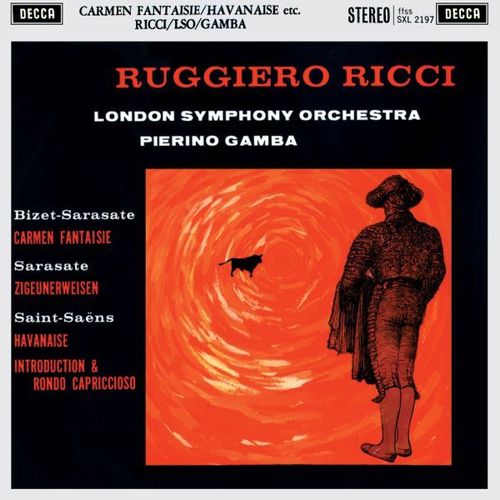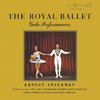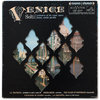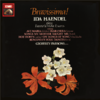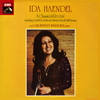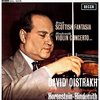AAA 100% Analogue This LP was Remastered using Pure Analogue Components Only from the Master Tapes through to the Cutting Head
Speakers Corner / Decca SXL 2197 - 180 Gram Virgin Vinyl
AAA 100% Analogue - Limited Edition
Pure Analogue Audiophile Mastering - Pressed at Pallas Germany
This LP has stunning sound and the music is excellent. Don't pass it up you will regret it if it goes out of print.LPreview
Speakers Corner 30 Years Pure Analogue This LP is an Entirely Analogue Production
BIZET (ARR. SARASATE) / Carmen Fantaisie - SARASATE / Zigeunerweisen - SAINT-SAËNS / Havanaise Bizet (arr. Sarasate): Carmen Fantaisie / Sarasate: Zigeunerweisen / Saint-Saëns: Havanaise,
Introduction and Rondo Capriccioso - Ruggiero Ricci, London Symphony Orchestra conducted by Pierino Gamba.
Some violinists enrapture their audience with their purity of tone, others with their warm timbre, or their amazing technical virtuosity. Pablo de Sarasate y Navascuéz was one of the very few violinists who combined all these merits, and in addition was a composer in his own right. The most famous of his 50 works are Zigeunerweisen, based on traditional gypsy folklore and the fiendishly difficult Carmen Fantasy.
And what better proof is there than Saint-Saëns’s Rondo capriccioso that it is perfectly possible to unite high-spirited joyfulness with a minor key. As the name suggests, his Havanaise is filled with the melodies and colourful rhythms of Spain: no wonder this piece is known as “the violinists' warhorse”. It goes without saying that these 19th-century bravura pieces are an absolute “must” for all those who wish to join the annals of great virtuoso violinists.
And today, 40 years after the making of this recording, general consensus has it that Ruggiero Ricci has taken his rightful place among the great virtuosos.
the performance of these virtuoso works by Sarasate and Saint-Saëns are quite exciting. Ricci's performance is what might be expected from a performance of this era -- a little too much vibrato, a little too much bow pressure, and an occasional cavalier disregard for intonation and articulation -- all things that make recordings from this era so very stimulating. Ricci's performances are all about character and are a perfect match for all four works here. Nothing is held back; every shift and every frenetic tempo is a huge risk. But these risks are what will keep listeners on the edge of their seats. This recording is not for anyone looking for flawless execution, but is highly recommended for listeners seeking too hear a skilled violinist having fun making music and doing an incredible job of it.
While it can be frustrating when recording labels throw in an extra piece of music on an album just because there happens to be enough time left, it's equally irksome when they completely shortchange you by using just barely half of the available space. Such is the case with this album, with a total time of about 38 minutes. Granted, the original Decca program is preserved, but Ricci recorded extensively and surely another of his bravura performances could have been added.
All that aside, the performance of these virtuoso works by Sarasate and Saint-Saëns are quite exciting. Ricci's performance is what might be expected from a performance of this era -- a little too much vibrato, a little too much bow pressure, and an occasional cavalier disregard for intonation and articulation -- all things that make recordings from this era so very stimulating. Ricci's performances are all about character and are a perfect match for all four works here. Nothing is held back; every shift and every frenetic tempo is a huge risk. But these risks are what will keep listeners on the edge of their seats. This recording is not for anyone looking for flawless execution, but is highly recommended for listeners seeking too hear a skilled violinist having fun making music and doing an incredible job of it.
Recording: September 1959 at Kingsway Hall, London by Alan Reeve / Production: James Walker.
Musicians:
Ruggiero Ricci, violin
Pierino Gamba, conductor
London Symphony Orchestra
Selections:
Georges Bizet (1838 - 1875)
1. Carmen - Fantaisie
Pablo de Sarasate (1844 - 1908)
2. Zigeunerweisen
Saint-Saëns (1835 - 1921)
3. Havanaise
4. Introduction and Rondo Capriccioso
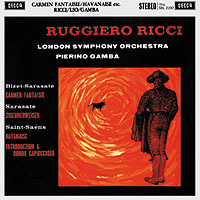
25 Years pure Analogue
Are your records completely analogue?
Yes! This we guarantee!
As a matter of principle, only analogue masters are used, and the necessary cutting delay is also analogue. All our cutting engineers use only Neumann cutting consoles, and these too are analogue. The only exception is where a recording has been made – either partly or entirely – using digital technology, but we do not have such items in our catalogue at the present time
Are your records cut from the original masters?
In our re-releases it is our aim to faithfully reproduce the original intentions of the musicians and recording engineers which, however, could not be realised at the time due to technical limitations. Faithfulness to the original is our top priority, not the interpretation of the original: there is no such thing as a “Speakers Corner Sound”. Naturally, the best results are obtained when the original master is used. Therefore we always try to locate these and use them for cutting. Should this not be possible, – because the original tape is defective or has disappeared, for example – we do accept a first-generation copy. But this remains an absolute exception for us.
Who cuts the records?
In order to obtain the most faithful reproduction of the original, we have the lacquers cut on the spot, by engineers who, on the whole, have been dealing with such tapes for many years. Some are even cut by the very same engineer who cut the original lacquers of the first release. Over the years the following engineers have been and still are working for us: Tony Hawkins, Willem Makkee, Kevin Gray, Maarten de Boer, Scott Hull, and Ray Staff, to name but a few.
At the beginning of the ‘90s, in the early days of audiophile vinyl re-releases, the reissue policy was fairly straightforward. Companies such as DCC Compact Classics, Mobile Fidelity, Classic Records and others, including of course Speakers Corner, all maintained a mutual, unwritten code of ethics: we would manufacture records sourced only from analogue tapes.
Vinyl’s newfound popularity has led many other companies to jump on the bandwagon in the hope of securing a corner of the market. Very often they are not so ethical and use every imaginable source from which to master: CDs, LPs, digital files and even MP3s.
Even some who do use an analogue tape source employ a digital delay line, a misguided ’80s and ‘90s digital technology that replaces the analogue preview head originally used to “tell” the cutter head in advance what was about to happen musically, so it could adjust the groove “pitch” (the distance between the grooves) to make room for wide dynamic swings and large low frequency excursions. Over time analogue preview heads became more rare and thus expensive.
So while the low bit rate (less resolution than a 16 bit CD) digital delay line is less expensive and easier to use than an analogue “preview head”, its use, ironically, results in lacquers cut from the low bit rate digital signal instead of from the analogue source!
Speakers Corner wishes to make clear that it produces lacquers using only original master tapes and an entirely analogue cutting system. New metal stampers used to press records are produced from that lacquer. The only exceptions are when existing metal parts are superior to new ones that might be cut, which includes our release of “Elvis is Back”, which was cut by Stan Ricker or several titles from our Philips Classics series, where were cut in the 1990s using original master tapes by Willem Makkee at the Emil Berliner Studios. In those cases we used only the original “mother” to produce new stampers.
In addition, we admit to having one digital recording in our catalogue: Alan Parsons’ “Eye in the Sky”, which was recorded digitally but mixed to analogue tape that we used to cut lacquers.
In closing, we want to insure our loyal customers that, with but a few exceptions as noted, our releases are “AAA”— analogue tape, an all analogue cutting system, and newly cut lacquers.
PALLAS
Audiophile Vinyl - Made in Germany For over 60 years the family business in the third generation of the special personal service and quality "Made by Pallas" is known worldwide. Our custom PVC formulation produces consistently high pressing quality with the lowest surface noise in the industry. Our PVC complies with 2015 European environmental standards and does not contain toxic materials such as Lead, Cadmium or Toluene. Our vinyl is both audiophile and eco-grade!
